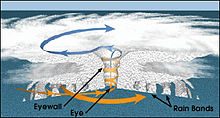Portal:Tropical cyclones/Featured article/Tropical cyclone
In meteorology, a tropical cyclone is a storm system with a spiral arrangement of thunderstorms, and a closed circulation around a center of low pressure, fueled by the heat released when moist air rises and condenses. The name underscores their origin in the tropics and their cyclonic nature. They are distinguished from other cyclonic storms such as nor'easters and polar lows by the heat mechanism that fuels them, which makes them "warm core" storm systems.
Depending on their strength and location, there are various terms by which tropical cyclones can be described, such as tropical depression, tropical storm, hurricane, and typhoon.
Tropical cyclones can produce extremely high winds, tornadoes, torrential rain (leading to mudslides and flash floods), and drive storm surge onto coastal areas. Though the effects on populations and ships can be catastrophic, tropical cyclones have been known to relieve drought conditions. They also carry heat away from the tropics, an important mechanism of the global atmospheric circulation that maintains equilibrium in the environment.
Recently featured: Cyclone Percy – 2005 Atlantic hurricane season – Hurricane Katrina – List of storms in the 2005 Atlantic hurricane season – Browse

